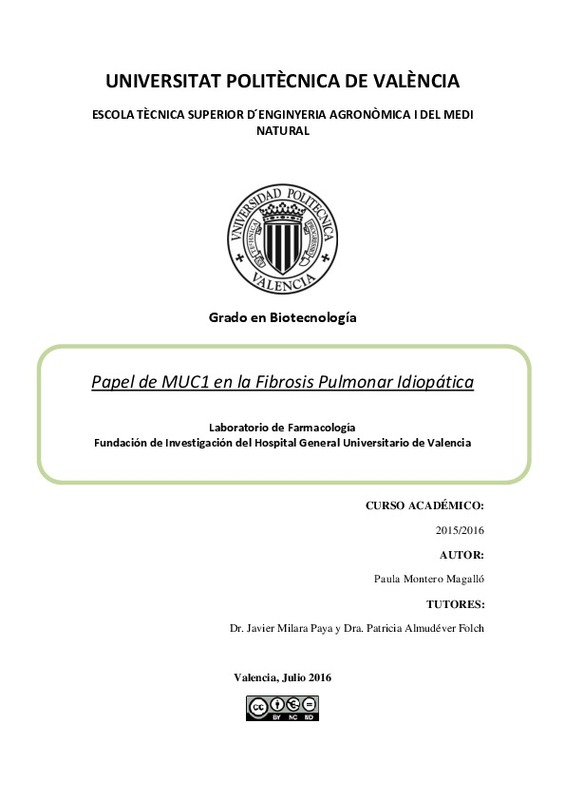|
Resumen:
|
[ES] La fibrosis pulmonar idiopática es una enfermedad pulmonar intersticial que afecta alrededor de 500000 personas en Europa. Se trata de una enfermedad pulmonar fibrótica que cursa con disnea, disminución de la función ...[+]
[ES] La fibrosis pulmonar idiopática es una enfermedad pulmonar intersticial que afecta alrededor de 500000 personas en Europa. Se trata de una enfermedad pulmonar fibrótica que cursa con disnea, disminución de la función pulmonar y cuya esperanza de vida es de 2 a 5 años desde el momento del diagnóstico.
Actualmente se considera como una enfermedad proliferativa en la cual tiene lugar la activación de los fibroblastos pulmonares y la transformación a miofibroblastos de diferentes tipos celulares como son las células epiteliales alveolares tipo II, las células endoteliales y musculares vasculares así como los pericitos, fibrocitos circulantes y células mesoteliales. Hoy en día existe la hipótesis de que los procesos fibróticos e invasivos de la fibrosis pulmonar presentan un paralelismo a nivel molecular con aquellos que ocurren en procesos neoplásicos. Es por ello que en este trabajo se ha decidido estudiar la posible intervención de MUC1, glicoproteína asociada a la formación de tumores, en FPI, tratando de estudiar los distintos mecanismos intracelulares en los que interviene dicha proteína. Para ello, en primer lugar se estudiará el nivel de expresión de MUC1 en pacientes con FPI respecto a individuos control, mediante las técnicas de inmunohistoquímica, RT-PCR y Western Blot. Por otro lado se llevará a cabo el silenciamiento del gen muc1, mediante RNA de silenciamiento, en una línea de células epiteliales alveolares tipo II, para posteriormente estudiar mediante las técnicas de western blot y RT-PCR y mediante el kit Smad Binding element reporter la participación de MUC1 en distintas rutas intracelulares relacionadas con la FPI.
[-]
[EN] Idiopathic pulmonary fibrosis is an interstitial lung disease which affects about to 500,000
people in Europe. This fibrosing disease is characterized by dyspnea, lung functional
impairment and it has an estimated ...[+]
[EN] Idiopathic pulmonary fibrosis is an interstitial lung disease which affects about to 500,000
people in Europe. This fibrosing disease is characterized by dyspnea, lung functional
impairment and it has an estimated survival of 3-5 years after diagnosis. Currently, it is
considered as a fibrotic proliferative disease in which both the activation of lung fibroblasts and
transformation from different cell types to miofibroblasts have a pathogenic key role. This
transformation may occur from alveolar type II cells, vascular endothelial cells, pericytes,
circulating fibrocytes and mesothelial cells. Nowadays it is known that the extracellular region
of MUC1 (KL-6) is a biomarker for IPF and that MUC1 is involved in the regulation of
proliferative processes in several diseases, but especially in cancer. Therefore, the aim of this
work is to investigate the potential intracellular role of MUC1 in IPF, trying to study the
intracellular mechanisms in whom this protein is involved. To do so, we assessed MUC1-Ct
participation in the signaling pathways triggered by transforming growth factor β1 (TGF-β1),
which is the main profibrotic factor, trying to elucidate interactions between MUC1-Ct and the
characteristic proteins of these signaling pathways. The results shown in this study support the
idea of MUC1 participating, at an intracellular level, in the cellular processes involved in IPF,
taking part in the TGF-β1 signaling pathway through its interaction with p-Smad2/3. Therefore,
the pharmacological modulation of MUC1 could be a potential target in IPF.
[-]
|







